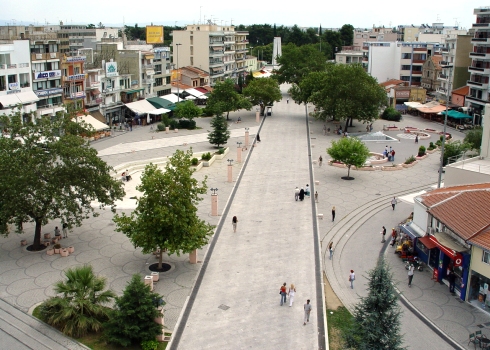Welcome to Komotini

The city's history is closely connected with that of Via Egnatia, the Roman trunk road which connected Dyrrhachium with Constantinople. The Roman emperor Theodosius I built a small rectilinear fortress on the road at a junction with a route leading north across the Rhodope Mountains toward Philippopolis. For most of its early existence the settlement was overshadowed by the larger town of Mosynopolis to the west, and by the end of the 12th century, the place had been completely abandoned.
In 1207 following the destruction of Mosynopolis by the Bulgarian tsar Kaloyan, the remnant population fled and established themselves within the walls of the abandoned fortress. John Kantakouzenos mentions the place for the first time under the name Koumoutsinas in his account of the Byzantine civil war of the early 14th century.
In the Ottoman Era, Komotini was known as Gumulcine. Its historical population has included Greeks, Turks, Jews, Armenians, Bulgarians and Pomaks. The city continued to be an important hub connecting the capital city of Constantinople with the European part of the Empire, and grew accordingly. Many monuments in the city today date to this era. During the first Balkan War, Bulgarian forces captured the city, only to surrender it to the Greek army during the second Balkan War on July 14, 1913.
The Treaty of Bucharest, however, handed the city back to Bulgaria. Despite various schemes by Greek inhabitants to avoid Bulgarian occupation, the city was part of Bulgaria until the end of World War I. In this period, a short-lived independent state, the Republic of Gumuljina, was established in Western Thrace. Komotini, was declared as capital city of that state. In 1919, in the Treaty of Neuilly, Komotini was handed back to Greece, along with the rest of Western Thrace.
Today, at the heart of the city lie the evergreen Central Park of Agia Paraskevi and the 15 m-high WW2 Heroes' Memorial, locally known as 'The Sword'. The revamped Central square or Plateia Irinis (Square of Peace) is the focus of a vibrant nightlife boosted by the huge number of students living in the city. The Old commercial centre is very popular with tourists as it houses traditional shops and workshops that have long vanished from other Greek cities.
In addition, in the northwestern outskirts of the city (Nea Mosinoupoli) locals and tourists alike flock into a modern shopping mall: Kosmopolis Park, which houses department stores, shops, supermarkets, a cinema complex, cafés and restaurants. Southwest of the central square one can find the Open-air Municipal Theatre, which hosts many cultural shows and events such as the cultural summer. Komotini has several museums including the Archaeological, Byzantine and Folklore museums.
6 km NE of Komotini is the Nymfaia forest. It has recreational facilities which comprise trails, courts, playgrounds and space for environmental studies. The forest is divided by a paved road which leads to the Byzantine fortress and the historical fort of Nymfaia.
The population is quite multilingual for a city of this size and it is made up of local Greeks, Greek refugees from Asia Minor and eastern Thrace, Greek Muslims, Turks, Pomaks, Roma, descendants of Armenian refugees, and recent refugees, including Greeks, from the countries of the former USSR (mainly Georgia, Armenia, Russia and Kazakhstan).
Komotini is an established university city in the North of Greece known for its high standard of education and the unique and unforgetable 'Komotini student experience'. The Komotini campus has a dynamic population of approximately 5-10.000 students and a major part of social life evolves around it. The founding of the University of Thrace in 1973 has had a significant positive influence on the entire urban area fuelling the city's expansion and growth.
There is, also, an impressive array of sports facilities available. They include the Municipal Stadium of Komotini (Home of Panthrakikos FC), Panthrakiko Stadium (training grounds), Municipal Sports Complex (NE of the city), Municipal Swimming pool and Basketball Arena, Democritus University Sports Complex including an Arena and an Aquatic Centre as well as Basketball courts in almost every school in the city. The mountainous area in the north of the city is ideal for mountain-biking and trekking as well as 4x4 racing both of which take place throughout the year.
Komotini is near three airports. The nearest is in Alexandroupoli (65km), the other is in Kavala (110km) and the last one is situated in the city of Thessaloniki (250 km). It has good rail and bus links to all continental Greek cities as well as Istanbul, and the good provincial road network has been supplemented by the new Egnatia Motorway.





